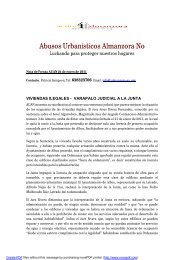European Property Rights and Wrongs - Diana Wallis MEP
European Property Rights and Wrongs - Diana Wallis MEP
European Property Rights and Wrongs - Diana Wallis MEP
Create successful ePaper yourself
Turn your PDF publications into a flip-book with our unique Google optimized e-Paper software.
sense, meaning the fullest right a legal system may confer upon a person with<br />
regard to immovable property, in civil law terminology “ownership” <strong>and</strong> in common<br />
law terminology “freehold” or “leasehold”. Although in all EU legal systems<br />
buyers <strong>and</strong> sellers of homes are guided by legal experts (civil law notaries on the<br />
Continent of Europe <strong>and</strong> solicitors in common law jurisdictions, supported by<br />
l<strong>and</strong> registrars), still the complexities of cross-border transfers may be enormous.<br />
Although the private law status of immovable property (who is owner, are<br />
there, e.g., any servitudes resting on the property?) may be clear from the l<strong>and</strong><br />
registry – <strong>and</strong> it should be noted that not all l<strong>and</strong> registries in the EU provide a<br />
full <strong>and</strong> complete overview of these rights – frequently the public law status is<br />
not so clear. An example of how things can go wrong is the Ley de Costas in<br />
Spain. As a result of this Act, unknowing home owners (also, so it seems, uninformed<br />
by the conveyancing experts who bear the final responsibility for the<br />
legal documentation of the transaction) are now confronted with unexpected<br />
expropriation measures from local authorities, claiming that their homes were<br />
built illegally in environmentally protected coastal regions. In my view, the right<br />
of establishment of EU citizens may be directly affected by such public law limitations,<br />
particularly when they are unknown or difficult to find, <strong>and</strong> which may<br />
even be seen as capable of hindering, directly or indirectly, actually or potentially,<br />
intra-Community trade. By the latter I refer to the famous CJEU decision in the<br />
Dassonville case. 36 In that case the ECJ expressed its opinion regarding trading<br />
rules having an equivalent effect of restricting trade in the sense of article 34 TFEU<br />
<strong>and</strong> which are, therefore, not allowed, because they frustrate the creation of an<br />
internal EU market. As a final note it might be interesting to say that the <strong>European</strong><br />
L<strong>and</strong> Registry Association (ELRA) is now working on a Common Conveyancing<br />
Reference Framework as part of its Cross-Border Electronic Conveyancing Project<br />
(CROBECO). 37 This is a remarkable initiative from l<strong>and</strong> registrars, who, using the<br />
available Internet technology <strong>and</strong> the resulting on-line data interchange of information,<br />
aim to facilitate cross-border transfers by allowing conveyancing experts<br />
who are not from the Member State in which the immovable is located to effect<br />
such transfer. It should be noted, however, that national organisations of con-<br />
36 Case 8/74 (Procureur du Roi v. Dassonville) [1974] ECR 834.<br />
37 More information can be found on the ELRA webpages: www.elra.eu.<br />
47



